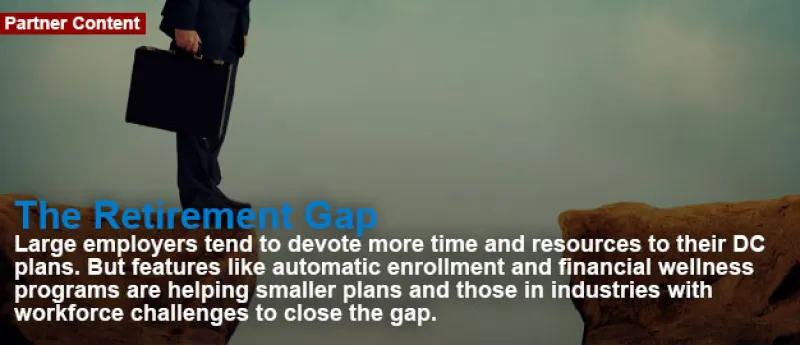When it comes to helping their employees achieve a comfortable retirement, some companies have been more successful than others. A recent survey by Institutional Investor, in partnership with Prudential, of more than 500 sponsors of 401(k) plans with assets of $50 million and above and nearly 300 consultants and advisers, revealed some striking differences among plans of different sizes and from different industries. Sponsors' self-assessment as to their overall plan health and participants' prospects for a secure retirement varied dramatically, as did participation rates and availability of automatic enrollment, auto-escalation and target date funds.
“Size of company is generally the primary driver” of differences between plans, says Ryan Gardner, managing partner and senior consultant at Fiduciary Investment Advisors, which advises clients with an average $100 million to $200 million in assets. “The larger plan sponsors, regardless of industry, tend to have more internal resources to allocate to the administration of their retirement plan.”
Less than half (49 percent) of employers with $50 million to $100 million in assets rated their plan's overall health excellent or near-excellent, compared with 65 percent of those with more than $100 million; only 47 percent of the smaller plans rated themselves effective at helping employees achieve a successful retirement, versus 57 percent of larger plans. This disparity reflects factors that may be endemic to companies of differing size and scale of resources. A solid majority (59 percent) of larger plans said they were able to obtain a highly competitive fee structure, for example, compared with 45 percent of the smallest.
A case in point is Sandia Corp., which has a $3.2 billion 401(k) plan with nearly 11,000 participants, many of them long-term employees who also participate in a defined benefit plan that is closed to new hires. To save on fees, the 401(k) offers collective trusts and separate accounts rather than retail mutual funds. “In some cases we've negotiated lower fees because of the size of the combined assets in our pension and defined contribution plans,” says Leah Mitchell, manager of retirement investment management.
Differences among industries were often stark as well. While all reported that more than half of their workforce participated in their DC plan, at health care companies only 58 percent participate compared with 69 percent at financial services firms and 70 percent at capital goods makers, for instance. More troublingly, only 43 percent of health care companies gave themselves high marks for overall plan health; the next lowest score, for energy and utility companies, was 53 percent. Well under half of health care (42 percent) and energy and utility companies (39 percent) said they are highly effective at helping participants achieve a successful retirement, compared with 57 percent of financial services firms and 73 percent of basic materials suppliers. Clearly, a substantial number of health care and energy and utility companies feel they could be doing a better job for their DC plan participants.
Industry differences in participant behavior also stood out. Plan sponsors said employees are not saving enough at almost three-quarters (74 percent) of health care companies and more than six out of ten consumer and retail companies (62 percent). Employees are far less likely to accept the default option when automatic enrollment is offered at health care (37 percent) and technology, media and telecommunications companies (42 percent) than at energy and utility companies (70 percent), for example. Although some of the findings were to be expected—financial services and business and professional firms generally reported healthier plans and better saving and investment practices by their participants—others raised questions.
Jennifer Flodin, defined contribution practice leader at Pavilion Advisory Group, where some 50 percent of assets under advisement are with health care system and hospital clients, notes that structural issues in some industries, including health care, may keep employers from providing optimal DC plans. The health care sector has seen extensive merger and reorganization activity over the past decade, Flodin notes, resulting in plans with legacy plan design features that are often mismatched to the sponsor's current employee demographics. Contribution rates for well-paid doctors are often low, in some cases because they have significant savings outside their DC plan that they are relying on for their retirement. ”In addition, health care organizations tend to have a fair number of workers who may not be eligible for the plan or who may already participate in a plan with another employer,” Flodin says.
No industry is monolithic, however. Indeed, in our survey as well as one-on-one interviews we found that companies of every industry and every size have pockets of weakness when it comes to achieving plan wellness. At financial services firms, 63 percent of plan sponsors said employees are not saving enough. At Pacific Life Insurance Co., which sponsors a $1 billion 401(k) plan with 2,300 active participants who generally have high saving levels, more than 500 participants still contribute less than 6 percent of pay to the plan, says Patrick Paynter, group retirement analyst. At energy and utility companies, by contrast, less than half (49 percent) of plan sponsors said employees are not saving enough.
Smaller plans are just as likely as larger ones to be adopting features that boost participation and saving rates. Ninety percent of plans with less than $100 million in assets expected to be offering auto-enrollment in the next three years—almost the same level as plans with over $1 billion (93 percent)—whereas slightly more of the smallest plans (89 percent) expect to offer auto-escalation than do the largest plans (87 percent). And more than eight of ten plans (81 percent) with less than $100 million expect to be offering target dates funds in next year, although they still lag plans with over $1 billion (93 percent).
“Nudges” like these are one reason smaller companies may be raising their game. And while many of them may have fewer resources to devote to their DC plan, larger companies face many of the same challenges—in particular, workforce diversity. “Most plans have a range of participant demographics, and you need a way to reach all these participants,” says Gardner. “We have large investment companies as clients, and one might assume that the majority of participants are sophisticated investors. But within these plans are also support staff, operations, administration and others whose expertise is in these areas other than investments.”
At distiller Brown-Forman Corp., which sponsors corporate and union plans with a collective $448 million in assets and 2,600 participants, the usual pattern is reversed, and employees under 30 may be better positioned at this stage in their careers to retire with an 80 percent income replacement rate than their older colleagues. While they save less—at 5.4 percent of salary, less than half the rate of boomers—many of the latter did not start saving early enough and only ramped up their saving rate in later years, says Donna Wimbec, senior manager of global benefits compliance. Automatic enrollment has helped younger employees greatly, she says, but she also credits Brown-Forman's employee resources groups (ERGs), which give subsets such as women and younger employees a forum to discuss issues specific to them and help to target and tailor communications more closely to members' needs. Wimbec and the company's recordkeeper have worked directly with the ERGs to understand their specific concerns and tailored the plan's education and communication campaigns to address those concerns.
Financial wellness plans, which link financial counseling and education with programs to promote emotional and physical well-being, are another way for plan sponsors to achieve closer contact with employees. Not only does financial wellness focus more on individual employees' needs, it enables them to identify financial issues that could affect their general health — and their workplace performance.
BMC Software, a tech firm with $700 million in 401(k) assets that launched a financial wellness program three years ago, has “a broad demographic base with a lot of different ages requiring different communication styles,” notes Natasha Taylor, director of global benefits. Companies with a similar profile should do their best to offer “as many tools and resources as possible,” she says.
For many smaller companies lacking resources, and for many in industries whose employees are less financially sophisticated or less focused on long-term saving, this is more difficult. But tools that can make a difference are more accessible to these companies than ever before. Automatic enrollment and auto-escalation can help them overcome employee inertia, or harness it to encourage saving. Target date funds allow them to put participants on a risk-adjusted glide path to a specific retirement saving target. Both plan sponsors and consultants note that tailored education and communication tools are becoming more widely available from recordkeepers and third-party providers. Together, the greater availability of automatic features and customized communications create opportunities to close the gap for smaller companies and those in industries that have struggled to boost participation and saving rates.
ABOUT THE SURVEY
This study was developed by Institutional Investor, in partnership with Prudential, to identify the investment risks and behavioral challenges that need to be addressed throughout the retirement planning process and how plan sponsors, advisers and consultants are trying to overcome them.
To support this research, a survey was distributed to Institutional Investor's audience of plan sponsors as well as advisers and consultants between January and February 2016. We received 511 completed survey responses from the plan sponsor audience and 295 completed survey responses from advisers and consultants.
Auto Enrollment: An automatic contribution arrangement that can be used as a feature in a retirement plan to allow employers to enroll employees in the company’s plan automatically upon meeting eligibility requirements.
Auto Escalation: A plan design option that allows a plan sponsor to increase participant deferrals annually by a set increment.
RISKS: Investing involves risk. Some investments are riskier than others. The investment return and principal value will fluctuate, and shares, when sold, may be worth more or less than the original cost, and it is possible to lose money. Past performance does not guarantee future results. Asset allocation and diversification do not assure a profit or protect against loss in declining markets.
The target date is the approximate date when investors plan to retire and may begin withdrawing their money. The asset allocation of the target date funds will become more conservative as the target date approaches by lessening the equity exposure and increasing the exposure in fixed income type investments. The principal value of an investment in a target date fund is not guaranteed at any time, including the target date. There is no guarantee that the fund will provide adequate retirement income. A target date fund should not be selected based solely on age or retirement date. Participants should carefully consider the investment objectives, risks, charges, and expenses of any fund before investing. Funds are not guaranteed investments, and the stated asset allocation may be subject to change. It is possible to lose money by investing in securities, including losses near and following retirement.
© 2016 Prudential Financial, Inc. and its related entities. Prudential, the Prudential logo, the Rock symbol and Bring Your Challenges are service marks of Prudential Financial, Inc., and its related entities, registered in many jurisdictions worldwide.
0297564-00001-00






